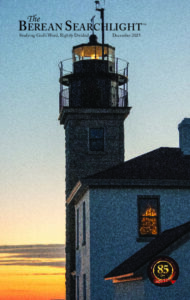In Chapter 3, God parted the Jordan River so the Jews could cross it to enter the Promised Land. God instructed that Israel’s priests lead them across, carrying the ark of the coven-ant, the presence of God in the Old Testament. They stopped in the middle of the river, holding back the wrath of that raging overflowing river (Josh.3:15), a type of how Christ held back God’s wrath on our sins when He died for them.
But now that they have crossed over, God tells Joshua to have 12 men go back to the middle of the river and pick up 12 stones to leave on the shore where they were camped (4:1-3) as a “memorial” (v.7) of their deliverance. Those 12 men were types of the 12 apostles, making their memorial a type of the Lord ’s Supper, which was done “in remembrance” of the Lord’s death, burial and resurrection (Luke 22:14-19).
There’s something we can learn about the Lord’s Supper from this type. It wasn’t the stones that held back the river’s wrath, they were just memorials of God who held it back. And the bread and cup don’t save us from our sins, they are just memorials of Christ who saves us from our sins.
Joshua 4:6,7 shows God didn’t just want the Jews to remember what He did for them that day. He wanted their children’s children to remember it as well, even though they hadn’t seen the deliverance. That’s a type of how the Lord’s Supper memorial will help Tribulation Jews remember the Lord who delivered them, “whom having not seen,” they will love (I Peter 1:6-8). The way that Tribulation Jews will get through their trials and temptations will be by remembering the Lord. It helps us get through our trials and temptations as well. Any difficulty you have in life can melt away if you put it in perspective by remembering you’re sure you are going to heaven because Christ delivered you from God’s wrath. And one of the things that helps us remember
Him and what He did for us is the Lord’s Supper.
Next, Joshua took 12 stones from the middle of the river and made a memorial there, where the priests’ feet stood. They were types of Christ (Heb.3:1). Israel’s priests offered animal sacrifices, but Christ offered Himself as a sacrifice (Heb.10:11,12). Priests could never sit down because people kept sinning, and bringing them animals to sacrifice to pay for their sins. But after Christ ascended into heaven, He sat down at God’s right hand to prove His work was finished. Joshua 4:10 says Joshua parked those memorial stones where the priests stood “until everything was finished that the Lord commanded Joshua.” The work of the priests that day was a type of the finished work of Christ (cf. John 19: 30). He finished all the work needed to pay for our sins.
When Israel’s high priest offered sacrifices, he wore an ephod that had “stones of memorial” on it, bearing the names of Israel’s 12 tribes (Ex.28:1-12). That symbolized how—as far as anyone knew—Christ was only supposed to die for Jews (Isa.53:5,8; Mt.1:21; 20:28). The apostle Paul revealed the mystery that He would die for Gentiles too (ITim.2:5,6).
The Jews “hasted” to cross the river (Josh.4:10) because a raging river is a fearsome thing. But drowning wasn’t the only thing they feared, as we see when 40,000 armed Jews led the crossing (Josh.4:12,13). They were anticipating the battle they’d encounter from the demonic giants who dwelt in Canaan, who did not want them to inherit their land. As we saw in our study of Chapter 1, those two and a half tribes were types of Old Testament saints who will rise from the dead to lead the charge against Antichrist and his armies at Armageddon, so saved Jews can enter the kingdom.
Did you ever wonder why God didn’t tell Moses to put a stone memorial in the midst of the Red Sea after they crossed it? It’s because God’s enemies “sank into the bottom as a stone” (Ex.15:4,5; Neh.9:11). They always sink to rise no more (Jer.51:63,64; Rev.18:21), so there was no stone memorial on the shore to commemorate their resurrection either!
A video of this sermon is available on YouTube: “The 12 Memorial Stones” Joshua 4:1-13




